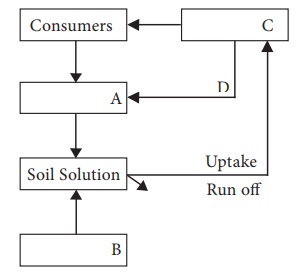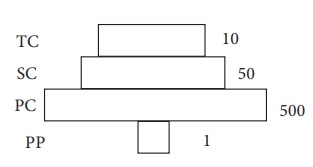Chapter: 12th Botany : Competitive Examination Questions
Plant Ecology - Competitive Examination Questions
UNIT
IX - Plant Ecology
1. Plants which produce characteristic
pneumatophores and show vivipary belong to
a)
Halophytes
b) psammophytes
c) hydrophytes
d) mesophytes
2. Mycorrhizae are the example of
a) amensalism
b) antibiosis
c)
mutualism
d) fungistatis
3. If ‘+’ sign is assigned to beneficial
interaction, ‘-’ sign to detrimental and ‘0’ sign to neutral interaction, then
the population interaction represented by ‘+’ ‘-’ refers to
a) mutualism
b) amensalism
c) commensalism
d)
parasitism
4. Which of the following is correctly matched?
a) Aerenchyma - Opuntia
b) Age pyramid - Biome
c)
Parthenium hysterophorus - Threat to
biodiversity
d) Stratification - Population
5. An association of individuals of
different species living in the same habitat and having functional interactions
is
a) Population
b) Ecological niche
c)
Biotic community
d) Ecosystem
6. Roots play in significant role in
absorption of water in
a) Wheat
b) Sunflower
c)
Pistia
d) Pea
7. If we uncover half of the forest
covering the earth, what crisis will be produced at most and the first?
a.
Some species will be extinct
b. Population and ecological imbalance
will rise up
c. Energy crisis will occur
d. Rest half forests will maintain this
imbalance.
8. Most animals are tree dwellers in a
a)
Tropical rain forest
b) Coniferous forest
c) Thorn woodland
d) Temperate deciduous fo
9. Cuscuta is an example of
a)
Ectoparasitism
b) Brood parasitism
c) Predation
d) Endoparasitism
10. Large woody vines are more commonly
found in
a) Alphine forests
b) Temperate forests
c) Mangroves
d)
Tropical rain forests
11. Niche overlap indicates
a) Active co-operation between two
species
b) Two different parasites on the same
host
c)
Sharing of one or more resources between the two species
d) Mutualism between two species
12. Which one of the following pairs is
mismatched?
a) Savanna – Acacia trees
b)
Prairie – Epiphytes
c) Tundra – Permafrost
d) Coniferous forest – Evergreen trees
13. Which ecosystem has the maximum biomass?
a) Grassland ecosystem
b) Pond ecosystem
c) Lake ecosystem
d)
Forest ecosystem
14. Which of the following would appear
as the pioneer organisms on bare rocks?
a) Mosses
b) Green algae
c)
Lichens
d) Liverworts
15. In which of the following both pairs
have correct combination?
a) Gaseous nutrient cycle Sulphur
Sedimentary nutrient cycle : - Nitrogen and Carbon and Phosphorous
b) Gaseous nutrient cycle Sedimentary
nutrient cycle : - Sulphur and Phosphorous Carbon and Nitrogen
c)
Gaseous nutrient cycle Sedimentary nutrient cycle : - Carbon and Nitrogen Sulphur and Phosphorous
d) Gaseous nutrient cycle Sedimentary nutrient
cycle : - Carbon and Sulphur Nitrogen and Phosphorous
16. Secondary succession takes place on
/ in
a) newly created pond
b) newly cooled lava
c) bare rock
d)
degraded forest
17. In an ecosystem the rate of
production of organic matter during photosynthesis is termed as
a) Secondary productivity
b) net productivity
c) Net primary productivity
d)
gross primary productivity
18. Natural reservoir of phosphorous is
a)
rock
b) fossils
c) sea water
d) animal bones
19. Secondary productivity is rate of
formation of new organic matter by
a)
consumers
b) decomposers
c) producers
d) parasites
20. Which one of the following processes
during decomposition is correctly described?
a) Catabolism – Last step in the
decomposition under fully anaerobic condition
b) Leaching – Water soluble inorganic
nutrient rise to the top layers of soil
c)
Fragmentation – Carried out by organisms such as earthworms.
d) Humification – Leads to the
accumulative of a dark coloured substance humus which undergoes microbial
action in a very fast rate.
21. Which one of the following is not a
functional unit of an ecosystem?
a) Energy flow
b) decomposition
c) Productivity
d)
stratification
22. The upright pyramid of number is
absent in
a) Pond
b)
forest
c) lake
d) grassland
23. The rate of formation of new organic
matter by rabbit in a grassland is called
a) net productivity
b)
secondary productivity
c) net primary productivity
d) gross primary productivity
24. The second stage of hydrosere is
occupied
by plants like
a) Azolla
b) Typha
c) Salix
d)
Vallisneria
25. Which one of the following is a
characteristic feature of cropland ecosystem?
a) Ecological succession
b) Absence of soil organisms
c)
Least genetic diversity
d) Absence of weeds
26. Most animals that live in deep
oceanic waters are
a)
Detritivores
b) Primary consumers
c) Secondary consumers
d) Tertiary consumers
27. During ecological succession
a) The changes lead to a community that
is in near equilibrium with the environment and is called pioneer community.
b)
The gradual and predictable change in species composition occurs in a given
area.
c) The establishment of a new biotic
community is very fast in its primary phase.
d) The number and types of animals
remain constant.
28. The mass of living material at a
trophic level at a particular time is called
a)
Standing crop
b) Gross primary productivity
c) Standing state
d) Net primary productivity
29.Match the following and select the
correct option
Column I Column II
(I) Earthworm (i) pioneer species
(II) Succession (ii) Detritivore
Ecosystem service (iii) Natality (IV)
Population growth (iv) Pollination
I II III IV
a) I : i, II: ii, III: iii, IV:
iv
b) I : iv, II: i, III:
iii, IV: ii
c) I : iii, II: ii, III:
iv, IV: i
d)
I : ii, II: i, III: iv, IV:
iii
30. Given below is a simplified model of
phosphorous cycling in a terrestrial ecosystem with four blanks (A – D.
Identify the blanks.

A
B C D
a) Rock minerals - Detritus - Litter
fall - Producers
b) Litter fall - Producers - Rock minerals - Detritus
c)
Detritus - Rock minerals - Producers - Litter fall
d) Producers - Litter fall - Rock
minerals - Detritus
31. If 20 J of energy is trapped at
producer level, then how much energy will be available to peacock as food in the
following chain?
Plant → Mice → Snake → Peacock
a)
0.02 J
b) 0.002 J
c) 0.2 J
d) 0.0002 J
32. Given below is an imaginary pyramid
of numbers. What could be one of the possibilities about certain organisms at
some of the different levels ?

a) Level one PP is ‘pipal trees’ and the
level SC is ‘sheep’.
b) Level PC is ‘rats’ and level SC is
‘cats’
c)
Level PC is ‘insects’ and level SC is ‘small insectivorous birds’
d) Level PP is ‘phytoplanktons’ in sea
and ‘whale’ on top level TC
33. Which one of the following
statements for pyramid of energy is incorrect, whereas the remaining three are
correct?
a) It is upright in shape
b) Its base is broad
c) It shows energy content of different
trophic level organisms
d)
It is inverted in shape
34. Which one of the following animals
may occupy more than one trophic levels in the same ecosystem at the same time?
a) Goat
b) Frog
c)
Sparrow
d) Lion
35. Both hydrarch and xerarch
successions lead to
a) Highly dry conditions
b) Excessive wet conditions
c)
Medium water conditions
d) Xeric conditions
36. Of the total incident solar
radiation the proportion of PAR is
a) More than 80%
b) About 70%
c) About 60%
d)
Less than 50%
37. The breakdown of detritus into
smaller particles by earthworm is a process called
a) Mineralisation
b) Catabolism
c) Humification
d)
Fragmentation
38. The biomass available for
consumption by the herbivores and the decomposers is called
a) Gross primary productivity
b)
Net primary productivity
c) Secondary productivity
d) Standing crop
39. The correct sequence of plants in a
hydrosere is
a)
Volvox → Hydrilla → Pistia → Scirpus → Lantana → Oak
b) Pistia→Volvox→Scirpus→Hydrilla→Oak →
Lantana
c) Oak→Lantana→Volvox→Hydrilla→Pistia
→Scirpus
d) Oak→Lantana→Scirpus→Pistia→Hydrilla
→Volvox
40. About 70% of the total global carbon
is found in
a) Forests
b) Grasslands
c) Agro ecosystems
d)
Oceans
41. Consider the following statements
concerning food chains
i) Removal of 80% tigers from an area
resulted in greatly increased growth of vegetation.
ii) Removal of most of the carnivores
resulted in an increased population of deers.
iii) The length of food chains is
generally limited to 3 – 4 trophic levels due to energy loss.
iv) The length of food chains may vary
from 2 to 8 trophic levels.
Which two of the above statements are
correct?
a) i and ii
b)
ii and iii
c) iii and iv
d) i and iv
42. Which one of the following is not
used for construction of ecological pyramids?
a) Dry weight
b) Number of individuals
c) Rate of energy flow
d)
Fresh weight
43. The UN Conference of Parties on
climate change in the year 2012 was held at
a. Lima
b. Warsaw
c. Durban
d.
Doha.
44. Which of the following are most
suitable indicators of SO2 pollution in the environment?
a. Algae
b. Fungi
c.
Lichens
d. Conifers
45. Which of the following is not one of
the prime health risks associated with greater UV radiations through the
atmosphere due to depletion of stratospheric ozone?
a. Damage to eyes
b.
Increased liver cancer
c. Increased skin cancer
. Reduced Immune system
46. A location with luxuriant growth of
lichens on the trees indicates that the
a. trees are very healthy
b. trees are heavily infested
c. location is highly polluted
d.
location is not polluted.
47. The ozone of atmosphere in which the
ozone layer is present is called
a. ionosphere
b. mesosphere
c.
stratosphere
d. troposphere
48. Which one of the following is a
wrong statement?
a. Most of the forests have been lost in
tropical areas.
b.
Ozone in upper part of atmosphere is harmful to animals.
c. Greenhouse effect is a natural phenomenon.
d. Eutrophication is a natural
phenomenon in freshwater bodies.
49. Good ozone is found in the
a. mesosphere
b.troposphere
c.
stratosphere
d. ionosphere
50. Chipko movement was launched for the
protection of
a.
forests
b. livestock
c.wetlands
d.grasslands
51. Identify the correctly matched pair.
a. Basal convention – Biodiversity conservation
b.
Kyoto protocol -Climatic change
c. Montreal protocol -Global warming
d. Ramsar convention -Ground water pollution
52. Common indicator organism of water
pollution is
a. Lemna pancicostata
b. Eichhornia crassipes
c.
Escherichia coli
d. Entamoeba histolytica
53. Which country has the greatest
contribution for the hole formation in ozone layer?
a.
Russia
b. Japan
c. USA
d Germany
Related Topics